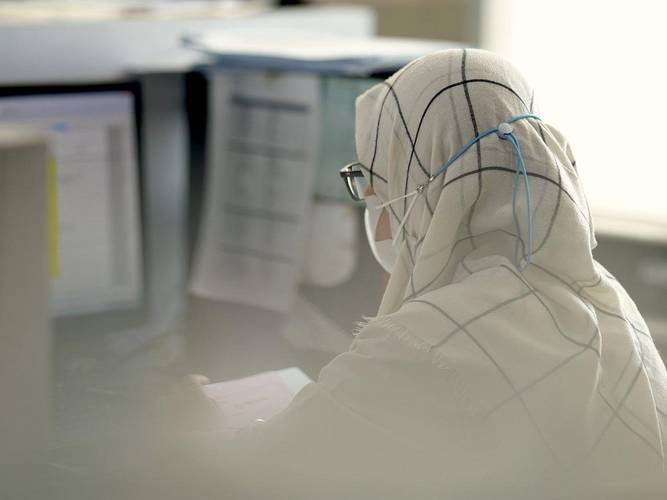The Human Rights Ombudsman discussed a complaint on the alleged discrimination of a female student in wearing a hijab during practice at the Faculty of Health Sciences Novo mesto. After inquiries, he found that the Faculty Rules do not explicitly prohibit headscarves, but the restrictions are inconsistent with the legal right to equal treatment and religious freedom. The Ombudsman warned the Ministry of Higher Education that the restrictions in the Rules of the Faculty of Health Sciences do not comply with legal and constitutional provisions. After the intervention of the Ombudsman, the Ministry ensured that the Faculty supplemented the Rules. This now allows the wearing of a headscarf made of washable material, under certain conditions, thus respecting the right to religious freedom and equal treatment.
***
The Human Rights Ombudsman of the Republic of Slovenia (Ombudsman) discussed a complaint regarding the alleged discrimination of a female student wearing a hijab during practice at the Faculty of Health Sciences Novo mesto. The Ministry of Higher Education, Science and Innovation (MVZI) warned that the wearing of the headscarf falls within the scope of freedom of conscience from Article 41 of the Constitution of the Republic of Slovenia (URS)[1], but regardless of this, the duty to ensure and protect freedom of religion does not mean that any (state) measure that touches on religious issues already represents an impermissible interference with freedom of religion, since in accordance with Paragraph 3 of Article 15 of the URS, human rights and fundamental liberties limited by the rights of others and in constitutionally determined cases[2].
Discrimination due to any circumstance is prohibited (Paragraph 2 of Article 4 of the Protection Against Discrimination Act (ZVarD)). Furthermore, in Paragraph 6 of Article 7 of the Higher Education Act (ZViS), it is stipulated that higher education institutions provide equal treatment regardless of nationality, race or ethnic origin, national and social origin, gender, state of health, disability, religion or belief, age, sexual orientation, marital status, financial status, or other personal circumstance.
The Ombudsman further reminded the MVZI that in the past, he had already addressed the issue of the use of religious headwear in nursing care and reported on it on page 127 of the Annual Report for 2021, which is published on the Ombudsman's website. At that time, he found that the authorities forbid the wearing of headscarves by female nurses in Slovenian hospitals for two fundamental reasons, namely for hygiene reasons and so-called broader social reasons. It was established that hygienic reasons in themselves cannot justify the prohibition of wearing a headscarf, when the headscarf is included in the regime of daily changing and washing at the operator of the activity, or as a one-time-use accessory and thus meets the hygiene requirements[3]. This was also testified to by the case of a young doctor from the Celje hospital, who wears a Muslim headscarf, which was highlighted in the media[4].
Broader social reasons (e.g. establishing trust with the patient, communicating recognition and professional affiliation, cultural-aesthetic rules) may be legally relevant under certain conditions [5], but such restrictions interfere with the human right to freedom of conscience, and therefore require appropriate legal regulation both from a formal point of view (interference with human rights is admissible when it is based on the law), as well as from a substantive point of view (proportionality of the interference with human rights). Since there is (was) no such regulation, the Ombudsman concluded at the time that, until a possible new legal regulation, the ban on wearing a headscarf appears to be inconsistent with the religious freedom of caregivers.
In the specific case, the Ombudsman pointed out to the Ministry that, in addition to the above aspects, an additional one is indicated: when prohibiting headwear, the higher education institution refers to the internal Rules on the Implementation of Clinical Training, which do not even specifically regulate this issue.
The Rules on the Implementation of Clinical Training for students of the Senate of the University of Novo Mesto, Faculty of Health Sciences (hereinafter: the Rules) does not explicitly prohibit long skirts or headscarves. In Article 15 of the Rules, training guarantees students in clinical training, among other things, the right to respect their personality and dignity, as well as to offer support in the development of personal and professional identity. Among the duties of the student, among other things, care for personal presentation is stated (Article 16). This is regulated in more detail in Article 18 of the Rules: “A student in clinical training wears the prescribed uniform with the Faculty logo. The uniform consists of: tunic, short-sleeved shirt, skirt or trousers, fleece jacket, and shoes. The uniform must be of the correct size, clean, ironed, and in perfect condition. Wearing other jackets or long-sleeved clothes under the uniform is not allowed.”
In the mentioned case, questions were therefore raised about the appropriateness of the current rules, which were supposed to prohibit female students from wearing headwear and long skirts during clinical practice. Firstly, the Rules do not contain explicit prohibitions on wearing headwear and long skirts; secondly, the Rules are an internal act of the Faculty that interferes with the religious freedom of female students, and such interferences are generally only permissible on the basis of a legal regulation; and thirdly, according to the complainant, no such restrictions are prescribed at other faculties in Slovenia, which indicates unequal treatment of female students from different faculties. The Ombudsman contacted the MVZI for clarification
The MVZI explained that, based on inquiries from the Ministry of Health, they found that the provisions of the document of the Chamber of Health and Midwifery of Slovenia – Association of Professional Societies of Nurses, Midwives and Health Technicians of Slovenia 'Professional image of healthcare providers and providers of midwifery care and nursing care providers' are used for mandatory clinical practice and laboratory work (hereinafter: Act of the Chamber – Association) and that the Rules of the FZV were prepared on the basis of this act
Furthermore, the MVZI stated, among other things, that in the chapter External Image, the Act of the Chamber – Association stipulates: "More detailed instructions on personal grooming and protection in the workplace (work clothes, footwear, and protective equipment) are prescribed by employers in accordance with the applicable legislation and the risk assessment of the workplaces, as the contractors' workplaces are diverse. Providers must comply with specific requirements set by medical institutions or their organisational units for professional reasons. Any individual cultural peculiarities that affect the external appearance of the contractor should be addressed to the employer or, during training, to educational institutions. In addition to the mandatory presentation pin, it is welcome for patients, relatives, and also for employees if the work clothes make it possible to recognise the professional affiliation of the employees." From the above, the MVZI concluded that "therefore, the external appearance of healthcare and midwifery care providers is prescribed by employers based on the applicable legislation and the risk assessment of the specific workplace".
The Ombudsman could not agree with the above. It was not clear from the provisions of the FZV Rules that it was prepared on the basis of an act of the Chamber – Association, as stated by the MVZI, since the Rules do not mention it in the above-quoted provision, nor does they refer to it, but regulate the student's uniform independently.
The Ombudsman assessed that the main problem in the case under consideration lies precisely in the Rules of the FZV. First, the very Act of the Chamber – Union, on the basis of which the Rules of the FZV were prepared, does not prohibit the wearing of a headscarf or a long skirt at all. And secondly, the Act of the Chamber – Association even explicitly determines, allows, and directs that cultural peculiarities that affect the external appearance of the provider are (also) addressed to educational institutions during training: "Possible individual cultural peculiarities that affect the external appearance of the provider, must be addressed to the employer or, during training, also to educational institutions."
The Ombudsman therefore suggested that the MVZI examine the possibilities of intervening with the FZV in order to harmonise Article 18 of the Rules and its practice in the treatment of female students with the legally guaranteed right to equal treatment from Paragraph 6 of Article 7 of the ZViS, and with the provision of the Act of the Chamber – Association, which allows consideration of cultural peculiarities when arranging the external appearance.
After mediation by the Ombudsman, the MVZI ensured that the University of Novi Mesto finally ensured compliance with Article 7 of the ZViS by amending the Rules, the disputed part of which now reads: "Students in clinical training wear the prescribed uniform with the Faculty logo. The uniform consists of: a tunic with no more than three-quarter length sleeves, which must not be loose, a short-sleeved shirt, a knee-length skirt or long trousers, a fleece jacket, and shoes. The uniform must be the correct size, clean, ironed, and in perfect condition. The wearing of other jackets or long-sleeved clothing under the uniform is not permitted. It is allowed to wear a headscarf, which must be made of washable material (at 90 degrees). The headscarf must not be loose and must be tucked into the collar of the outer clothing.”
[1] In point 84 of decision number U-I-92/07-23 of 15 April 2010, the Constitutional Court states that positive religious freedom guarantees any (oral or written, private or public) expression of religion or belonging to a religion, including prayers and spreading religious truths, but also actions that imply compliance with religious rules are protected (worships, ceremonies, rituals, processions, use of religious clothes, symbols, etc.).
[2] See point 93 of the decision of the Constitutional Court number U-I-92/07-23 of 15 April 2010.
[3] From a hygiene point of view, a (regularly washed) headscarf is even less objectionable than uncovered hair (which is (not) washed every day).
[4] https://www.rtvslo.si/zdravje/bolnikom-je-vseeno-kako-sem-oblecena/609469
[5] See e.g. judgments of the Court of Justice of the European Union in case C-157/15 of 14 March 2017; in case C-188/15 of 14 March 2017; and in the combined case C 804/18 and C 341/19 of 15 July 2021.

